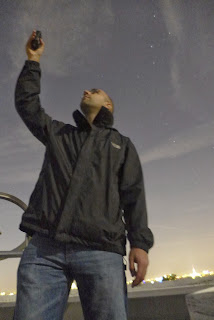[
click here for English version]
Sehen Sie genau so viele Sterne wie Ihre besten Freunde, wenn Sie den Nachthimmel ansehen? Das ist die Frage, die wir mit dem ersten "
Flashmob für die Wissenschaft" beantworten wollen. Soviele Personen wie möglich sollen die
Loss of the Night app am exakt gleichen Ort zur exakt gleichen Zeit benutzen. Indem wir die Sterne, die die Flashmobber sehen können, vergleichen, können wir herausfinden, wie gut die Ergebnisse der App sind.
Der Flashmob wird in Berlin stattfinden, aber Sie können uns von überall helfen, indem Sie die Veranstaltung auf Facebook posten, darüber twittern oder Ihnen bekannten Bloggern davon mitteilen. Wenn Sie in Berlin wohnen, sagen Sie auch Ihren Freunden und Kollegen Bescheid! Sie können Ihnen den Link zu
diesem Blogpost schicken.
Und falls es klar ist wo Sie wohnen, können Sie sich natürlich mit Freunden treffen und Beobachtungen aus Ihrer eigenen Stadt hinzufügen!
So funktioniert die Veranstaltung:
Flashmobber sollten die App im Voraus installieren. Android-Nutzer brauchen die
Loss of the Night app, und iOS-Nutzer können mit der Dark Sky Meter-App teilnehmen (
free oder
full version), die die Telefonkamera anstatt Ihrer Augen benutzt. Wenn Sie möchten, können Sie die App vorher tagsüber testen, um ein Gefühl dafür zu bekommen.
Sie sollten planen, die
Mitte des Gleisdreieck-Parks in Berlin (den grünen Pfeil, nicht das "A" auf
dieser Karte) gegen 20:30 Uhr zu erreichen. Sie können die App sofort starten, damit das Telefon schon im Nachtmodus ist, wenn die Messzeit beginnt. Schauen Sie die Sterne an und lassen Sie Ihre Augen an die Dunkelheit gewöhnen - Sie werden überrascht sein, wie viele Sterne man auch in der Mitte von Berlin sehen kann!
Sobald um 20:35 Uhr die astronomische Dämmerung endet und die echte Nacht beginnt, werden wir den Anwesenden mitteilen, dass die Zeit zum Sternensuchen gekommen ist.
Wenn Sie 7 Sterne gefunden haben, teilt die App mit, dass Sie aufhören können. BITTE HÖREN SIE NICHT AUF!
Mehr Sterne sind immer eine große Hilfe für uns, und werden für die Auswertung der Flashmob-Daten besonders wichtig sein. Daher wären wir sehr froh, wenn Sie mindestens 12 Sterne suchen würden. Wenn Sie die Geduld für 15-20 Sterne haben, wäre das noch toller, und wenn Sie 30 Sterne erreichen, verdienen Sie den Titel des Bürgerwissenschafts-Superhelden!
Wenn Sie mit der App fertig sind, können Sie sie einfach schließen und nach Hause gehen - Ihre Beobachtungsdaten werden beim Schließen der App automatisch an uns übertragen. Falls Sie in der Nähe Ihrer Wohnung einen guten Beobachtungsort haben (z.B. einen Park, Spielplatz oder eine Dachterrasse), dann wäre es ein super Bonus, wenn Sie dort noch eine zweite Beobachtung mit der App vornehmen würden. So könnten wir auch mehr Informationen über Berlin verteilt erhalten. Bitte nutzen Sie die App nur, wenn Sie eine zweite Person zur Sicherheit dabeihaben (die Sie zum Beispiel vorm Stolpern warnen kann, während Sie nach oben schauen!).
Bitte erzählen Sie so vielen Personen wie möglich über diese Veranstaltung, und schicken Sie ihnen den Link zu diesem Blogpost. Je mehr Personen teilnehmen, um so erfolgreicher wird dieser erste Flashmob für die Wissenschaft.
Ich freue mich darauf, morgen viele von Ihnen zu sehen!
 |
| I werde die Himmelshelligkeit mit einem Lichtmessgerät messen, und das Ergebnis mit dem der Flashmobber vergleichen. |
Anmerkungen:
(1) Mehr Informationen darüber, warum wir Individuen für Beobachtungen rekrutieren, anstatt Satelliten oder andere Sensoren zu verwenden, finden Sie in unseren
ersten Blogpost, oder diesem
Scientific American-Artikel. Hintergründe zur Bedeutung von Forschung zur Lichtverschmutzung gibt es in den Artikeln in
Die Welt,
The Guardian, oder den
Why Files.
(2) Falls sich direkt über dem Gleisdreieckpark eine kleine Wolke befinden sollte, die vermutlich schnell weiterzieht, werden wir die Teilnehmenden bitten, 15 Minuten mit den Messungen zu warten.










































